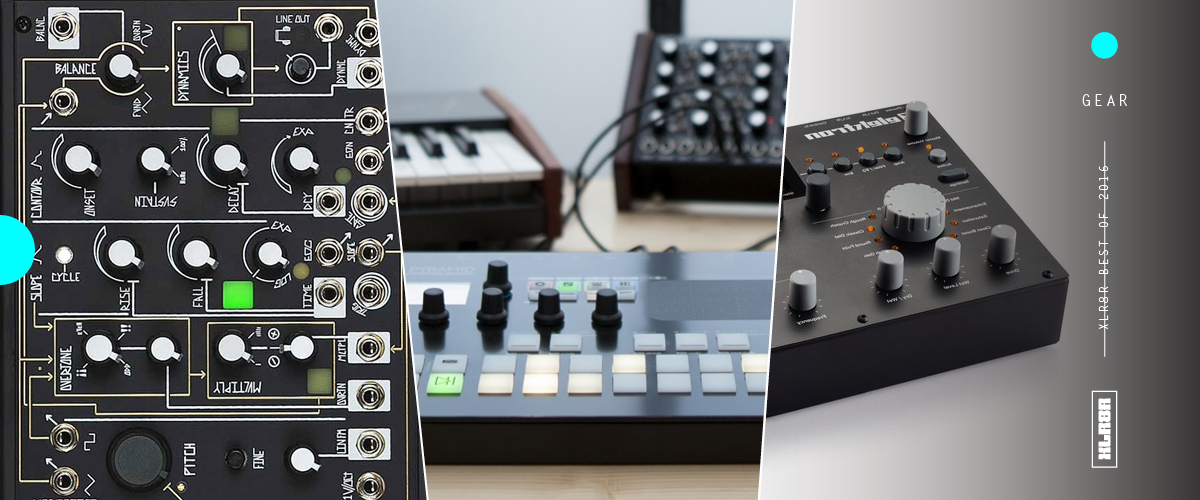XLR8R’s Best of 2016: Gear
We look back at our favorite pieces of gear released in 2016.

XLR8R’s Best of 2016: Gear
We look back at our favorite pieces of gear released in 2016.

In terms of music and music making, 2016 really stood out for the amount of accessible, analog gear that was released. Many of the premier companies in the space—Korg, Roland, Arturia, Elektron—released affordable updates to their lines, or new products altogether; the modular world and its various inclinations released inspiring modules and forward-thinking instruments; and newer boutique companies also popped up and made their voices heard with interesting kit in the sub-$1000 category. However you look at it, it was a standout year for gear—and with that, we round up our favorite pieces from 2016.
Ableton Link

While not technically a piece of gear, Ableton Link was one of the most significant developments for electronic music production this year. Essentially an open platform for wifi sync, Link distributes tempo information (along with the location of the downbeat of every bar) to various devices, allowing them to sync perfectly over a standard wifi network. Anyone can start and stop their part (or change global tempo) while others keep playing, allowing for improvisation. Link can sync multiple instances of Ableton Live and any supported iOS apps: MoMinstruments’ Elastic Drums, Alexandernaut’s Fugue Machine, Olympia Noise Co.’s Patterning, and Auxy’s Auxy, to name a few. While Live is the only supported DAW at this point, it’s not necessary — Link works standalone with any apps that support it.
Arturia DrumBrute

An analog drum machine that replaces samples with circuits, Arturia’s DrumBrute is one of the most accessible ways to get analog drum sounds into your productions. There are 17 drum instruments (including two kicks, a snare, a clap, open/closed hats, high/low toms/conga, etc), a zap, cymbal and reverse cymbal, and a two-mode Steiner-Parker filter on the main out. It serves well for live recording, with swing, randomness, a step repeat, a roller, and a looper and pretty much every form of connectivity to pretty much anything, analog or digital. If you’re looking for a small, portable MIDI keyboard, Arturia’s Keystep is also a winner.
Elektron Analog Heat

Elektron’s Analog Heat
” target=”_blank”>Analog Heat is a device that does one thing and does it extremely well. Essentially an analog sound processor, the Heat features eight different stereo distortion circuits with everything from tape-like saturation to nasty distortion, along with a stereo multi-mode filter and a two-band stereo EQ. There are modulation sources for these effects, including assignable envelopes and LFOs, making it easy to re-shape beats and create rhythmic textures. Elektron’s Overbridge integrates the Heat with computers, letting you apply proper analog processing inside the box. (Note: Elektron is also selling a cheaper pedal version of the Analog Heat called Analog Drive).
Critter and Guitari Organelle
A swiss army knife for both the studio and live performance, the Organelle” target=”_blank”>Organelle is a computer that runs Pure Data patches, in a build and form factor that makes it as tactile, immediate, and versatile as a guitar pedal. With ¼” inputs and outputs, mappable knobs, keys, and buttons, the device can be used as a synthesizer, sampler, or outboard effect. The Organelle ships with a set default patches like synths and delays, and new patches can be dumped onto the machine directly from a USB drive (see lots of patches here). If you’re handy with Pure Data, patches may be created and edited directly on the device—plug in a keyboard, mouse, and monitor and get to work.

Squarp Pyramid

As many of us attempt to detach from our computer screens while making music, Squarp’s Pyramid has stepped in as a great outboard sequencer, the likes of which are tough to come by in a single, self-contained box. It runs completely standalone, letting you program drum patterns and melodic lines on multiple external instruments using its various MIDI and CV outs. You can record your performance with a MIDI controller or the built-in keyboard and then edit your performance with various quantize options and MIDI effects, as well create rhythms and melodies with the built-in step sequencer. It’s a deep, well-designed box that can serve as the central brain of your hardware rig.
Bastl Instruments Kastle

To get a taste of what the modular synth phenomenon is all about at a tiny fraction of the cost, Bastl Instruments’ Kastle synth is a miniaturized incarnation of modularity that runs on three AA batteries and costs well under 100 bucks. It’s an all-in-one lo-fi synth, complete with oscillator, pitch/timbre/waveshape control, an LFO, and plenty more. It’s even got CV connections, so you can hook it up to a Eurorack modular for further control and manipulation.
Korg Minilogue

Korg’s polyphonic analog synth, dubbed the Minilogue, is quite a beast. Its 37 (slim) key, programmable synthesizer, with features including a polyphonic step and motion sequencer, an onboard tape-style delay, multiple sound shaping and filter options, and even a small, OLED oscilloscope display. It’s a lush, versatile, and well-built piece of kit full of smart touches and intuitive controls. Korg has also recently released a 25-key monophonic cousin to the Minilogue, the Monologue, with micro-tuning presets courtesy of Richard D. James himself.
MakeNoise 0-Coast
With features from both popular schools of synthesizer design (Bob Moog’s East Coast and Don Buchla’s West Coast styles), Make Noise’s 0-COAST is a single voice, patchable monosynth that can function either on its own or connected to a larger Eurorack setup. The 0-COAST is normalized with a signal chain that lets you plug it in and make sounds immediately without connecting a single patch cable, as well as 13 input and 14 output patch points for when you want to further freak it out. It’s got two channels of MIDI-to CV and MIDI-to-gate, a dual mode, MIDI-controlled arp, and all those other idiosyncratic MakeNoise stylings.


